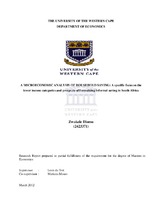| dc.description.abstract | The paper is a microeconomic analysis of household saving that specifically looks at whether informal saving should be formalised, the costs and benefits to formalising, what has been done and how this may be improved. A microeconomic study in respect of a developing country like South Africa is crucial, rather than blindly adopting the studies of developed countries. This is necessary for a developing country’s households as they have vastly different demographic structures, where most households are likely to be large and poor (Deaton, 1989: 61) and where money is earned from the sale of agricultural produce or low wages and income generated from informal enterprises and services.The Income and Expenditure Survey data of South African households is used in this paper to analyse the behaviour of poor households. The households are divided into 10 quintiles; each quintile represents 10 percent of all households in terms of per capita income. The poorest household is represented in the first quintile and the richest in the tenth quintile.The results of the Income and Expenditure Survey indicate that the poor are concentrated amongst blacks, females, and those living in rural areas. They also have the lowest educational level whereas the larger households are found here. Furthermore, the poor tend to spend more of their income on health, food, education and cultural activities. However, the savings of the poor is lower than the savings of the higher income categories. What is of concern is that the poor do actually save but their saving methods are less likely to be recorded formally. They often prefer the easy access and convenience of informal savings as compared to deposit and credit facilities of formal financial institutions which are difficult to access (Sukhdeve, 2008: 34). However,informal savings carry significant risk for the poor households and barely contribute to GDP.
The paper then looks at initiatives to improve the savings of the poor. Enhanced methods to save,accessibility of savings facilities, the reliability of these facilities and convenience will be investigated. These seem to be essential for the accumulation of cash in the long run. | en_US |

